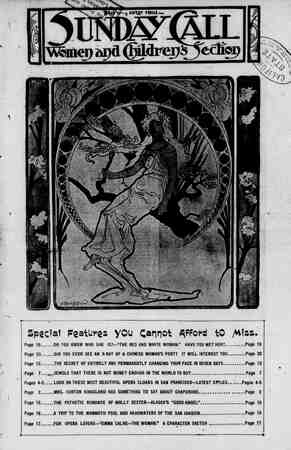The San Francisco Call. Newspaper, November 10, 1901, Page 9
You have reached the hourly page view limit. Unlock higher limit to our entire archive!
Subscribers enjoy higher page view limit, downloads, and exclusive features.
” Ebe Century Plant in JBloom. ANY people who see the enormous leaves and long M shooting flower of the commonly called “Century Plant” gaze at it with astonishment and not a little awe and pass it by. They do not know that this plant blooms but once in fifteen or twenty vears, and that that once means its death A few only know the exterior and interior wonders of the “Agave Americana Variegata.” Up in the Arizona gardens of Golden Gate Park. by the consegvatories, they stand like sentinels, their lofty heads gazing down in disdain on the ignorants of earth “The Agave,” derived from “Aganos,” signifying a’l- mirable, referring to the stately form in which some of them flower, is a native of Northern Mexico, where the sandy soil and general atmosphere are most beneficial to it. This plant flowers in from fifteen to twenty years in this climaté, but in the colder climes, owing as much, however, to the car¢ taken of them and the repotting. they have taken as long as forty and fiity vears, and gardeners despaired of ever seeing them flower and named them “The Century Plant.” In the park to-day there are about twenty different varieties, in all stages of existence The plant has its peculiarities and one desperate fault. As the flower begins to shoot forth it is sad to learn that it steals the life from the large, fleshy, tufted leaves, and on attaining perfection and the very height of its glory it commences to droop and gradually dies. There is fortunately a saving clause, however. Before death, at 2he very root, spring little suckers or baby “Agaves,” which are taken from the base of the leaves 14 A _/ 'NOYEMBER 107" I?Ol Pack’s Curiosity. Each of these suckers has a small root, which when placed in the ground begins at once to shoot and grow. The plants are different in sizes and colors, some of the leaves Leing yellow and green, some a solid dark green, as for instance “The Agave Shawii,” a giant stand- ing thirty feet from the ground, with a depth of ten feet and a girth of forty feet. Others again are more delicate and vari-colored. “The Agave Densiflora,” a very rare one, close flow- ered, of a greenish yellow, burst forth last year in a beau- tiful bloom. The seeds of the rarer ones are hard to get, most of them coming from Paris. These wonderful plants thrive in the sandy soil, with- out irrigation, and facing the harshest sea winds, grow up in all their beauty, and, as Mr. McLaren, the superintend- ent of the park, says, are “a most accommodating plant.” “The Agave Americana” was caught in the height of its bloom by the camera of Mr. Charles Weidner, and is shown on this page. It is extensively cultivated in Mexico, under the name of “Maguey,” and is put to many uses. The Mexican Government offers a bonus to any one who will plant “The Agave” in certain regions of Mexico, and is amply repaid by the revenue derived on the duty re- ceived from the various products of the plant on arriving at maturity. PHQTO BY CHAS.WEIDNER™ ¥ SiF. Bolden Gate [T

